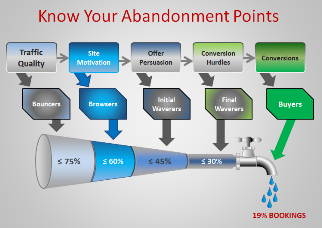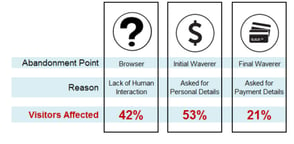If your travel booking website has abandonment issues, you’re in good company: according to a recent SaleCycle survey, 81% of visitors to travel industry websites left without completing their booking activity. With no similar surveys reporting contradictory findings, having to live with a high percentage of abandoned online bookings appear to be an inescapable reality for the foreseeable future. You’re also in good company if you find yourself asking, “Isn’t there any good news on this subject?” 
Fortunately, there is good news: visitors may be abandoning their booking activity on your site, but they’re not abandoning their travel plans – and they’re not abandoning online travel sites as the preferred means of booking that travel. In fact, 86% of respondents in that same survey said they customarily make their travel bookings online. This means your site is engaging with gun-shy, rather than fickle, consumers. They’re not going to change their minds from a romantic beach vacation to a MacBook Pro, but they’re not going to make a quick trip decision either.
Given these circumstances, a two-step approach - one part prevention and another part recovery – can be a very worthwhile way to mitigate your website’s abandonment issues and contribute to an uptick in revenues.
Improve Booking Abandonment Points
Booking abandonment is not a simple problem. In order to deploy an effective strategy you must use website, survey and social media analytics to glean insights into your abandonment points. Because each abandonment point usually has profile different from others, the focus should be on first identifying the points, then taking a customized approach to improve them.  The graphic to the right shows abandonment profiles for five stages of the conversion pipeline.
The graphic to the right shows abandonment profiles for five stages of the conversion pipeline.
Browser: at the browser stage the visitor is still a reasonable distance from making even a tentative booking. At this point, research by Oracle indicates the biggest factor leading to site abandonment is lack of human interaction – they need help finding information or answers to specific questions. For information, does your site have a searchable knowledge base or FAQ? For specific questions, does your site have a proactive Chat or Click-to-Call feature?
Initial Waverer: at this stage, the visitor has taken some tentative booking actions and created a shopping cart which functions more as a repository than an emerging purchase decision. It’s apparent that requests for personal details from a proactive Chat session can hurt – by spooking the visitor into abandoning the site, rather than help. A Virtual Assistant feature, configured to offer assistance services resembling a concierge function, may provide a greater sense of control and be less threatening.
Final Waverer: this is the stepping off point for a booking and where abandonment is the most painful! The associated point of failure – a request for payment details – is unavoidable (the credit card can’t process itself) and the abandonment risk can be anticipated. A proactive, interactive, strategy should be deployed in an earlier stage – perhaps using the Virtual Assistant in a concierge mode (as mentioned earlier) so this Final Waverer can be walked through the payment steps in a more personal way than the typical “continue” button sequence. 
There are also times when abandonment points are difficult to define or urgency around loss of revenue requires action before all the abandonment information can be gathered and analyzed. In those situations, existing practices should be checked to be certain these two best practices are being used.
Integrate service with real-time site activity: pages should be embedded with tailored information such as specialized FAQs and configured with customized, proactive, features like chat, click-to-call and virtual agents. Those two tactics will help engage the visitor in a supportive mode and encourage them to stay with their purchase activity. Since any issue which provides a reason to leave will likely succeed, it’s critically important to creating a supportive environment which can defuse such issues early and effectively.
Let the customer lead: the reasons for abandonment shown in the graphic share at least one underlying theme – a perceived lack of control from the visitor’s perspective. Examples: the Browser was failing to locate information and couldn’t figure out how to escalate to a human for help; the Initial Waverer was asked for personal details and felt threatened by how that information might be used; the Final Waverer baulked at payment details for much the same reason – where might this highly confidential data wind up? For all these reasons and more, a travel website should only provide simple and effective proactive support that clearly communicates to the customer the message that they are the ones in charge.
Deploy an Abandonment Recovery Strategy
Even when all efforts to avoid abandonment fail – and many will – successful travel companies will keep their eye on the larger picture: namely, the majority of abandoning visitors will ultimately purchase travel services and the only question is – where?
Therefore, those companies will focus efforts on deploying a recovery strategy to increase the odds they will earn the transaction instead of the competition. All recovery strategies are guided by a key tenet: the abandoning visitor will purchase travel – somewhere - in a relatively short period of time. Accordingly, most recovery strategies contain some variation of these five elements.
Recovery must be anchored by contact: yes, requesting personal information can precipitate booking abandonment, but the travel company must be able to contact the visitor to have any chance of recovering the transaction. Therefore, the site’s proactive support features must be configured to obtain visitor’s email addresses in a way that’s perceived as reasonable and mutually beneficial. Perhaps an email address becomes part of the initial booking process. Perhaps the visitor’s email is captured by registering for downloads of useful travel information well before the booking process even begins.
Recovery emails must be personalized: effective recovery emails are highly personalized and based on the most recent activity performed on the site. If the visitor started looking for high end travel to Argentina, only to switch over to mid-range travel to Southern California, they should only see references, offers and updates relating to their Southern California decision. Effective and convincing personalization conveys to the visitor the travel company is invested in them.
Recovery emails should follow an orchestrated sequence: the email sequence should begin quickly, within hours – reflecting the possibility abandonment was spurred by just a last minute urge to check prices or look at reviews one more time. Emails should then be balanced out to avoid creating an a negative “canned” effect over the next 36 hours. Beyond personalization, the text in each email should be customized for themes and subjects that reflect the time since abandonment.
Recovery must be convenient: each recovery email must have a link that returns the visitor to exactly where they were on the website when abandonment took place. This convenience will accomplish two practical goals: the visitor won’t be annoyed and by a requirement to reenter prior information; they can take either immediate action on their prior booking arrangements or do so after easy changes.
Emails should be supported by banner ads: in addition to an orchestration of emails, the recovery strategy should also contain banner ads synchronized with the emails – generally in a timeframe of 24-72 hours after abandonment. Just as with emails, the banner ads which follow the visitor on other websites should be highly personalized and reflect final choices and decisions made by the abandoning visitor before leaving the website.
A high level of commitment, operational discipline and accountability is required for this two-step approach to be effective and beneficial. However, the difference between a successful online travel agency and one that struggles year after year often boils down to the basics of controlling costs and capturing incremental revenue. While various studies claim recovery tactics can boost conversion rates anywhere from 20% to 30%, what travel companies would not gain an edge over competitors from an incremental increase of even 10%? More than ever, travel websites are searching for such an edge, and addressing booking abandonment issues can provide it.
















